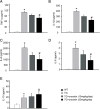Crocetin attenuates inflammation and amyloid-β accumulation in APPsw transgenic mice
- PMID: 30450117
- PMCID: PMC6208089
- DOI: 10.1186/s12979-018-0132-9
Crocetin attenuates inflammation and amyloid-β accumulation in APPsw transgenic mice
Abstract
Background: Crocetin, an agent derived from saffron, has multiple pharmacological properties, such as neuroprotective, anti-oxidant, and anti-inflammatory actions. These properties might benefit the treatment of Alzheimer's disease (AD). In the present study, we tested whether crocetin attenuates inflammation and amyloid-β (Aβ) accumulation in APPsw transgenic mice, AD mouse models. Cell viability and the levels of Aβ40 and Aβ42 in HeLa cells stably transfected with Swedish mutant APP751 were evaluated. Mice with Swedish mutant APP751 transgene were used as transgenic mouse models of AD, and were orally administrated with crocetin. Aβ protein and inflammatory cytokines were measured with ELISA. NF-κB and P53 were measured with western blot assay. Learning and memory were analyzed with Morris water maze and novel object recognition tests.
Results: Crocetin significantly reduced Aβ40 and Aβ42 secretion in Hela cells without effecting cell viability. In AD transgenic mice, crocetin significantly reduced the pro-inflammatory cytokines and enhanced anti-inflammatory cytokine in plasma, suppressed NF-κB activation and P53 expression in the hippocampus, decreased Aβ in various brain areas, and improved learning and memory deficits.
Conclusion: Crocetin improves Aβ accumulation-induced learning and memory deficit in AD transgenic mice, probably due to its anti-inflammatory and anti-apoptotic functions.
Keywords: Alzheimer’s disease (AD); Aβ accumulation; Crocetin; NF-κB; P53.
Conflict of interest statement
This study was approved by the ethics committee of Daqing Oilfield General Hospital, and followed the ethical guidelines laid down in the 1975 Declaration of Helsinki.All participants have given consent for publication.The authors declare that they have no competing interests.Springer Nature remains neutral with regard to jurisdictional claims in published maps and institutional affiliations.
Figures






Similar articles
-
Crocetin promotes clearance of amyloid-β by inducing autophagy via the STK11/LKB1-mediated AMPK pathway.Autophagy. 2021 Nov;17(11):3813-3832. doi: 10.1080/15548627.2021.1872187. Epub 2021 Jan 19. Autophagy. 2021. PMID: 33404280 Free PMC article.
-
Protective Roles of Monsonia angustifolia and Its Active Compounds in Experimental Models of Alzheimer's Disease.J Agric Food Chem. 2017 Apr 19;65(15):3133-3140. doi: 10.1021/acs.jafc.6b04451. Epub 2017 Apr 5. J Agric Food Chem. 2017. PMID: 28378593
-
Novel rat Alzheimer's disease models based on AAV-mediated gene transfer to selectively increase hippocampal Abeta levels.Mol Neurodegener. 2007 Jun 9;2:11. doi: 10.1186/1750-1326-2-11. Mol Neurodegener. 2007. PMID: 17559680 Free PMC article.
-
Neuroprotective Effect of SLM, a Novel Carbazole-Based Fluorophore, on SH-SY5Y Cell Model and 3xTg-AD Mouse Model of Alzheimer's Disease.ACS Chem Neurosci. 2017 Mar 15;8(3):676-685. doi: 10.1021/acschemneuro.6b00388. Epub 2016 Dec 29. ACS Chem Neurosci. 2017. PMID: 28032988
-
Tanshinone IIA attenuates neuroinflammation via inhibiting RAGE/NF-κB signaling pathway in vivo and in vitro.J Neuroinflammation. 2020 Oct 14;17(1):302. doi: 10.1186/s12974-020-01981-4. J Neuroinflammation. 2020. PMID: 33054814 Free PMC article.
Cited by
-
Paradigms and Success Stories of Natural Products in Drug Discovery Against Neurodegenerative Disorders (NDDs).Curr Neuropharmacol. 2024;22(6):992-1015. doi: 10.2174/1570159X21666230105110834. Curr Neuropharmacol. 2024. PMID: 36606589 Free PMC article.
-
Trans-sodium crocetinate suppresses apoptotic and oxidative response following myoglobin-induced cytotoxicity in HEK-293 cells.Iran J Basic Med Sci. 2024;27(6):768-774. doi: 10.22038/IJBMS.2024.75306.16322. Iran J Basic Med Sci. 2024. PMID: 38645503 Free PMC article.
-
Potential of phytochemicals in the treatment of Alzheimer disease by modulating lysosomal dysfunction: a systematic review.Chin Med. 2025 Sep 1;20(1):138. doi: 10.1186/s13020-025-01204-z. Chin Med. 2025. PMID: 40890872 Free PMC article. Review.
-
Crocetin Improves Dengue Virus-Induced Liver Injury.Viruses. 2020 Jul 30;12(8):825. doi: 10.3390/v12080825. Viruses. 2020. PMID: 32751420 Free PMC article.
-
Role of phytochemicals as nutraceuticals for cognitive functions affected in ageing.Br J Pharmacol. 2020 Mar;177(6):1294-1315. doi: 10.1111/bph.14898. Epub 2020 Feb 3. Br J Pharmacol. 2020. PMID: 31650528 Free PMC article. Review.
References
LinkOut - more resources
Full Text Sources
Molecular Biology Databases
Research Materials
Miscellaneous

